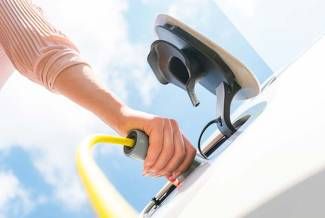Charging infrastructure for electric vehicles:
A guarantee of success for electromobility?
If the Federal Government's Charging Infrastructure Master Plan (I & II) is followed, Germany is to become the global lead market for electric mobility. In order to achieve this goal, however, the country first needs a nationwide charging infrastructure for electric vehicles, because electric vehicles need energy - a truism. To achieve this, a wide variety of measures are necessary that affect the construction industry, the energy industry and the transport sector. And even though the number of public charging points is growing steadily, the federal government itself is calling for "more speed in the expansion of charging infrastructure". Here we discuss how this can be achieved.
Charging infrastructure: challenges
So what are the challenges that need to be overcome in order for a nationwide expansion of the charging infrastructure for electric vehicles to succeed?
One of the biggest challenges is the infrastructure itself.
The reason? Many vehicles (still) need hours before they are fully charged. Therefore, charging points must be installed in sufficient numbers near the places where drivers normally park their vehicles.
Other challenges are:
1
2
3
4
5
6
7
8
Good to know:Technical aspects are crucial for a functioning infrastructure: charging points must be designed in such a way that they are suitable for all types of electric vehicles. For example, some vehicles need charging points that have a certain current strength so that the vehicle is charged properly and the battery is not damaged. Other aspects relate to e.g. plug types as well as current types (direct current vs. alternating current).
Current figures & data
According to theGerman Federal Network Agency, there are currently (as of October 2022) just under 60,000 normal charging points and almost 12,000 fast charging points in Germany.
Where are the opportunities for a better charging infrastructure for electric vehicles?
Despite the many challenges, a growing charging infrastructure offers many opportunities for car manufacturers and electric vehicle operators. For example, investing in high-quality charging stations can attract new customer groups and increase sales of electric vehicles.
In addition, the development of new technologies can improve the user experience. In particular, the introduction of smart grids could help to manage energy consumption more efficiently and further boost the use of renewable energy.
Read also our articles on
The important benefits of a nationwide charging infrastructure also include:
Nationwide charging infrastructure for electric vehicles is an important factor for their acceptance, use and diffusion.
The increased use of electrically powered vehicles to replace those with conventional combustion engines is more environmentally friendly, cleaner and quieter.
Regeneratively generated electricity for electric cars inevitably leads to a positive contribution to climate protection - as numerous studies testify.
The overall service life of an electric vehicle and the low maintenance requirements lead - compared to the combustion engine - to a lower cost balance.
Electric charging infrastructures are significantly easier to install and maintain than petrol pumps for gas, petrol, diesel and co. (and also less dangerous).
Local business activities are promoted by investments in charging systems, as companies and retailers gain new customer groups (e-car drivers).
Good to know: Admittedly, charging an e-car requires a change of mindset - compared to refuelling petrol or diesel vehicles - because charging a car battery requires time spans ranging from 10 minutes to several hours. However, if charging stations are located close to places where you can do another activity at the same time, such as shopping at the supermarket, drinking coffee at the petrol station, working at the office (or even at home overnight), then this rethinking is made easy.
Charging infrastructure: related topics & solutions from SWARCO
A better charging infrastructure for electric vehicles makes for a better future!
The charging infrastructure for electric vehicles is one of the key factors for the success of electromobility. While the number of e-vehicles is steadily increasing, it is important that the charging infrastructure also continues to be expanded to meet the growing demand.
At the same time, the existing charging infrastructure must be further improved and optimised to make electric mobility more attractive. With the right infrastructure, electric vehicles can advance the energy transition and revolutionise transport.
Last but not least: The increased use of renewable energies is a central building block for the mobility transition, the energy transition and more sustainability. In the transport sector, it is electromobility. Here, the charging infrastructure is an essential factor for the success of this technology. Therefore, we must take care to provide the necessary infrastructure to advance electromobility. This will allow us to use clean and efficient electric vehicles that are better for our environment.
FAQs – Frequently asked questions
The charging infrastructure refers to the various components required to charge a vehicle with electricity from the charging pole. These include, among others, the charger, the cable, plug types and the socket itself. Ideally, the charging infrastructure must be designed to meet the needs of all electronic vehicles.
Public charging infrastructure refers to a network of charging stations where e-cars are charged. These stations must be publicly accessible and usable for electric cars. Thus, public charging infrastructure is essential so that people with electric vehicles can drive longer distances without having to worry about their battery level.
The most common three types of charging points are the following:
Conventional charging columns: They are plugged into a normal socket and can be installed practically anywhere.
Inductive charging columns: They send electrical energy through a field generated between the column and the vehicle and therefore work without cables.
Solar charging stations: They are the most expensive type of charging pole, but also the most environmentally friendly, because they use solar energy to charge electric vehicles
With DC charging, the battery in the car is charged via direct current. In this way, high charging powers of 50 kW up to 240 kW are achieved. AC charging is gentler on the battery of the electric car, but DC charging works much faster.
AC charging (= charging with alternating current) is used for most e-cars. Since the battery itself can only be charged with direct current, the current must be converted. When converting alternating current to direct current (AC charging), charging powers between 10 and 25 kW are achieved. In some cases, up to 45 kW is possible.
There are different types of plugs for the connection between the power source and the car battery. The most important ones in Europe include the following:
Type 2 plug: This Combined Charging System (CCS) has been set as a standard by the EU. It is a simple plug connection with a capacity of up to 22 kW.
Combo-2 connector: This system is an extension of the Type-2 connector to enable charging by means of direct current (DC) in the higher power range (up to 350 kW).
CHAdeMO plug type: This system originates from Japan and competes with the Combo-2 plug - with a different arrangement and number of contacts.
Better charging infrastructure is needed to meet demand and drive the uptake of electric vehicles. It makes it possible to charge e-cars anywhere, which means more flexibility and convenience. Moreover, investing in better infrastructure is not only worthwhile for the environment, but also for the economy.


